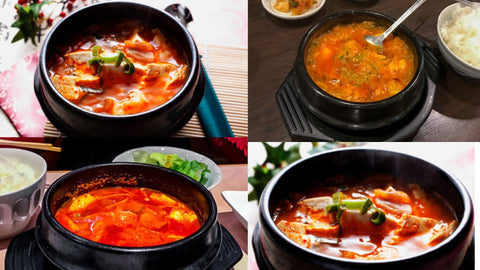Looking for a remedy to warm up your winter nights? A bowl of Jjigae would be the perfect comfort food for your late-night meal.

If you're wondering what Jjigae is, it is known as Korean stew, one of Korea's staple dishes. A bowl of Jjigae is typically made with various ingredients, including meat, seafood, tofu and vegetables. The base is made out of Gochujang (chilli paste) and some add Gochugaru (Korean chilli flakes) for extra spice and mixed with garlic, green onions, and soy sauce.
This is one of the easiest and most delicious dishes to make, especially during the freezing season. Most Jjigae is made with a similar base consisting of Gochujang, Gochugaru, black pepper, minced garlic, soy sauce or rice wine, salt and sugar. The variations of dishes depend on the meat or seafood you prefer to cook together.
Top 5 Delicious Jjigae Recipes

Kimchi Jjigae
This is one of the most popular options in almost every Korean restaurant. Nothing can go wrong with warm broth with Kimchi and meat! As Kimchi's taste gets much more complex over time, it is best to cook this dish with older or more fermented Kimchi.
It is boiled with meat, vegetables, and tofu, where the ingredients from the fermented Kimchi merge into a thick broth making the soup flavorful and concentrated.
In most Korean meals, Kimchi Jjigae is often served as a main dish shared by everyone at the table. It is often paired with grilled pork belly or meat as it balances the oiliness from the grilling.
Ingredients:
- Kimchi
- Pork Belly or other meat
- Gochugaru
- Gochujang
- Minced Garlic
- Black Pepper
- Cup Juice from Kimchi
- Tofu
- Spring Onion
- Rice wine
- Onions*
- Mushroom
Budae Jjigae

Also known as Army stew or spicy sausage stew was formed during the Korean war as the dish is made out of smuggled foods from the US Military bases. This dish is still trendy and served in restaurants specialising in budae jjigae.
After the war, the food supply was limited in South Korea. Therefore, the citizens consumed the leftover foods from the army camps. Most ingredients were then smuggled in through the black market.
Budae Jjigae is mostly a dish which includes different ingredients cooked together. It is now common to include various ingredients like cheese, instant noodles, tteok, mandu, meat, bacon and mushrooms.
Sundubu Jjigae

This dish's main ingredient is unpressed soft tofu cooked with vegetables, meat or seafood, which is added according to preferences. Most Koreans would crack an egg when the soup is boiling to top it off.
The history of Sundubu dates back to the Joseon Dynasty, as there is documentation showing this dish being served during the era. The dish also spread to Los Angeles as the American Military men brought this dish back with them after the war.
In the early '90s, the Sundubu Jjigae was rising in the US. A Korean immigrant opened the first sundubu restaurant on Vermont Avenue, expanding across the country into a national chain.
Saengseon jjigae or Maeuntang

If seafood is your thing, try this Spicy Fish Stew. It is made into a thick broth and served with Pollock, sea bass or cod fish. The fish is boiled with vegetables, usually watercress or chrysanthemum and flavoured with Gochujang to ensure the dish's spiciness.
Additionally, some would like to add seafood to the Jjigae for extra flavouring. Shellfish such as crabs, oysters or clams can be added to complement the soup.
This Saengson Jjigae is often eaten with Soju and is usually made out of leftover fish in restaurants, as Koreans would order this as a drinking snack.
Doenjang Jjigae

It is made out of Soybean paste which replaces the Korean Chilli Paste that is typically cooked in the basic jjigae. If you prefer a non-spicy option, try this dish!
Doenjang Jjigae dates back to the Three Kingdoms period when ingredients such as meat were insufficient. During winter, this dish is often consumed by the locals as they provide the right amount of protein.
Besides working as a protein substitute, Doenjang contains isoflavone, which prevents cardiovascular, osteoporosis and lecithin diseases. It also helps improve brain function in both children and adults. Soybean is also rich in dietary fibre, which is valuable for digestive system functions.






